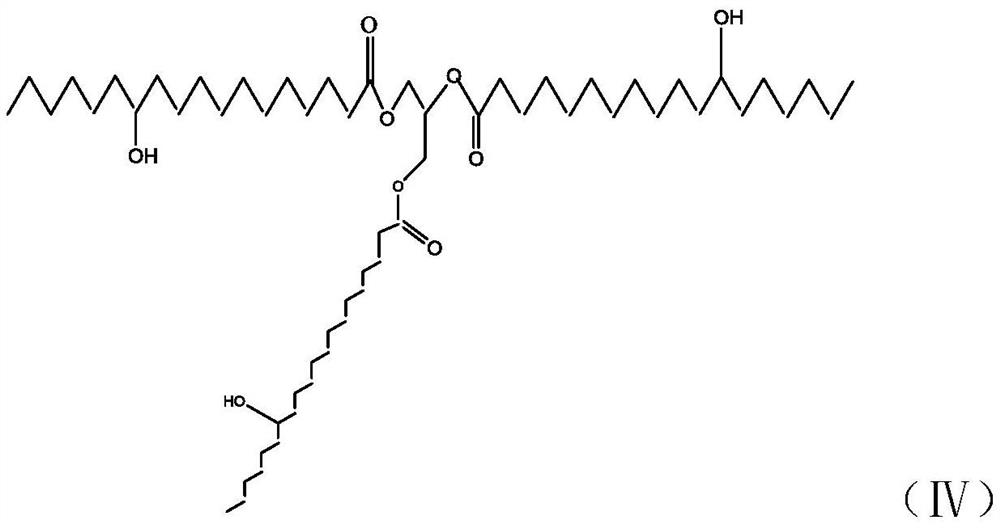A kind of comb structure polymer and its preparation method and use
A structural polymer, comb-shaped technology, applied in the direction of pigment slurry, etc., can solve the problems of difficult to achieve industrialization, harsh reaction conditions, high energy consumption, improve dispersion efficiency and stability, avoid polymer decomposition, and facilitate industrialization. Effect
- Summary
- Abstract
- Description
- Claims
- Application Information
AI Technical Summary
Problems solved by technology
Method used
Image
Examples
Embodiment 1
[0064] (1) In a 1L round-bottom four-necked flask with a stirrer, a condenser and a feeding port, add 235 g of propylene glycol methyl ether, stir and dissolve, and heat to 80°C. A mixture of 57 g of acrylic acid, 90 g of styrene, 23 g of glycidyl methacrylate and 2.4 g of n-dodecyl mercaptan was prepared, and an initiator mixture of 6 g of azobisisobutyronitrile and 15 g of propylene glycol methyl ether was prepared. The two mixtures were simultaneously added dropwise to the reactor at 80°C to start the polymerization reaction. The dropwise addition time was 4 hours. After the dropwise addition, the reaction was continued for 1 hour, resulting in a prepolymer containing epoxy groups in the side chain. The weight average molecular weight is 5433.
[0065] (2) adding the mixed solution of 240g polyetheramine (Jeffamine M2070), 40g hydrogenated castor oil, 0.5g triethylamine and 140g cyclohexane solvent to the reaction system of step (1) at one time after the insulation, at 80° ...
Embodiment 2
[0070] (1) In a 1L round-bottom four-necked flask with a stirrer, a condenser and a feeding port, add 230 g of propylene glycol methyl ether, stir and dissolve, and heat to 90°C. A mixture of 45 g of methacrylic acid, 90 g of butyl methacrylate, 70 g of glycidyl methacrylate and 9 g of tert-dodecyl mercaptan was prepared, and an initiator mixture of 10.8 g of dibenzoyl peroxide and 15 g of propylene glycol methyl ether was prepared. The two mixtures were simultaneously added dropwise to the reactor at 90 °C to start the polymerization reaction. The dropwise addition time was 3 hours. After the dropwise addition, the reaction was continued for 1 hour to generate a prepolymer containing epoxy groups in the side chain. The weight average molecular weight is 1768.
[0071] (2) the mixed solution of 189g polyetheramine (Genamin M 31), 18g hydrogenated castor oil, 0.9g triethylamine and 180g methylcyclopentane solvent was added at one time in the reaction system of step (1) after th...
Embodiment 3
[0076] (1) In a 1L round-bottom four-necked flask with a stirrer, a condenser and a feeding port, add 130 g of propylene glycol butyl ether, stir and dissolve, and heat to 70°C. 24g maleic acid, 48g alpha-methylstyrene, 36g allyl glycidyl ether and 4.8g alpha-methylstyrene linear dimer mixture, 4.8g azobisisoheptonitrile and 15g propylene glycol butyl ether agent mixture. The two mixtures were simultaneously added dropwise to the reactor at 70°C to start the polymerization reaction. The dropwise addition time was 5 hours. After the dropwise addition, the reaction was continued for 1 hour to generate a prepolymer containing epoxy groups in the side chain. The weight average molecular weight is 2674.
[0077] (2) add the mixed solution of 276g polyetheramine (Jeffamine M1000), 21.6g hydrogenated castor oil, 1.2g triethanolamine and 250g methylcyclopentane solvent to the reaction system of step (1) at one time after the insulation is completed, at 70 The graft modification reac...
PUM
| Property | Measurement | Unit |
|---|---|---|
| molecular weight distribution | aaaaa | aaaaa |
| molecular weight distribution | aaaaa | aaaaa |
| molecular weight distribution | aaaaa | aaaaa |
Abstract
Description
Claims
Application Information
 Login to View More
Login to View More - R&D
- Intellectual Property
- Life Sciences
- Materials
- Tech Scout
- Unparalleled Data Quality
- Higher Quality Content
- 60% Fewer Hallucinations
Browse by: Latest US Patents, China's latest patents, Technical Efficacy Thesaurus, Application Domain, Technology Topic, Popular Technical Reports.
© 2025 PatSnap. All rights reserved.Legal|Privacy policy|Modern Slavery Act Transparency Statement|Sitemap|About US| Contact US: help@patsnap.com



